|
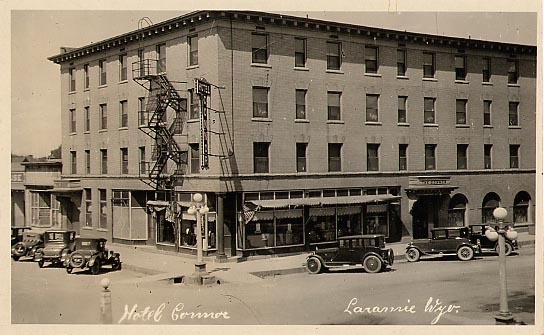
Connor Hotel, 1920
In January 1913, the
Connor Hotel, owned by Mrs.
W. E. Connor, on the corner of Grand Ave. and Third Street opened. The
hotel, once the glory of Laramie, is now utilized primarily for student and former student apartments. In fact, Number One Son
while a student occupied an apartment on the third floor.
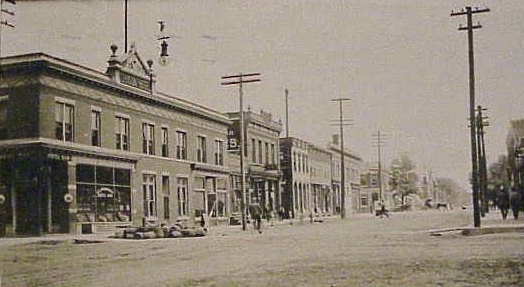
Johnson Hotel, corner of Grand and Front Street, 1911.
Other early hotels included the Johnson Hotel constructed in 1900 located on the corner of
Grand Avenue and 1st Street and the Kuster Hotel. The Johnson Hotel now houses a watering hole, Lovejoy's, named after
Elmer Lovejoy an early promotor of bicycles, the Lincoln Highway, and operator of an early garage.
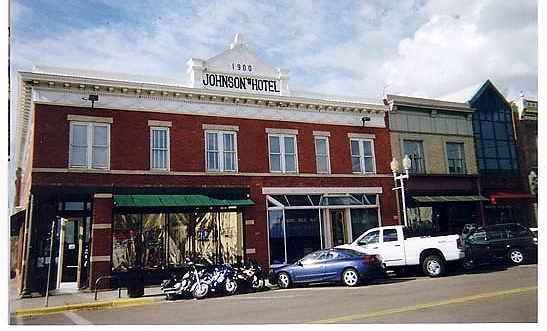
Johnson Hotel from Grand Ave., 2005. Photo by Geoff Dobson.
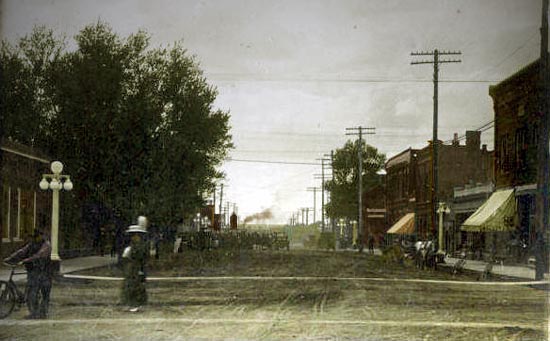
Grand Ave., looking west. Approx. 1907. All rights reserved G. B. Dobson.
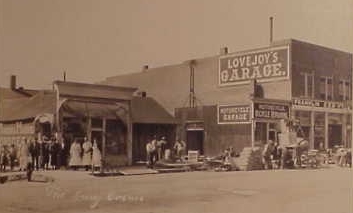 Lovejoy's Garage, undated
On April 7, 1894, a small notice in the Daily Boomerang ran:
Lovejoy's Garage, undated
On April 7, 1894, a small notice in the Daily Boomerang ran:
Elmer Lovejoy
dealer in
New & Second Hand Wheels
and
General Repairer
A full line of sundries on hand and to order on short notice. Removed from
over the post office to No. 301 Grand Avenue.
In 1897-1898, Lovejoy built his own horseless carriage. He ran, however, into a difficulty with the
steering. Carriages and wagons generally had the entire front axle pivot, which requires that
the front wheels either be placed out from the body or that the body curve over the
wheels so the wheels can be pivot. To solve the problem Lovejoy devised a "steering knuckle" or spindle which
permits each front wheel to pivot. Each steering knuckle is then connected by tie rods to the
steering mechanism. Steering knuckles are used in motor cars to this day. Not seeing a large future for
motor cars, Lovejoy sold rights to the steering knuckle to an eastern company receiving $800 and a Locomobile Steamer in
exchange.
In 1902, the right of the Electric Vehicle Company, manufacturer of electric-powered Hansom cabs
used in New York, to manufacture and sell the "Elliott" steering knuckle was confirmed. The Electric Vehicle
Company was owned by Andrew Lawrence Riker who was also employed by Locomobile to design their new 1902 gasoline powered
motor car. The Elliott steering knuckle was named after Sterling Elliott a
New England inventor. Today, some government specifications for motor vehicles still specify the use of
an "Elliott steering knuckle." Elliott became very wealthy. Today in South Florida, where he maintained his
winter "cottage," his memory is
honored by a museum in which is displayed, among other things, his Rolls Royces including a "shooting brake" [station wagon], as well as
the car which he kept on board his yacht for use when in port.
Today in Laramie, Elmer Lovejoy is remembered by having a bar and grill at the corner of Grand Ave. and 1st Street named after him.
The bar and grill features, among other things, micro-brewery type beers and a Thai chicken salad -- a good place
to watch a Saturday game.
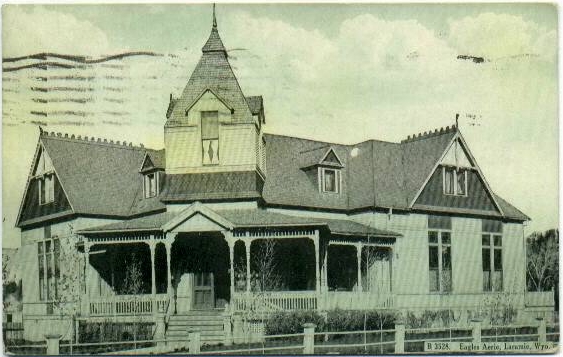
Laramie Eagles Aerie, 1910
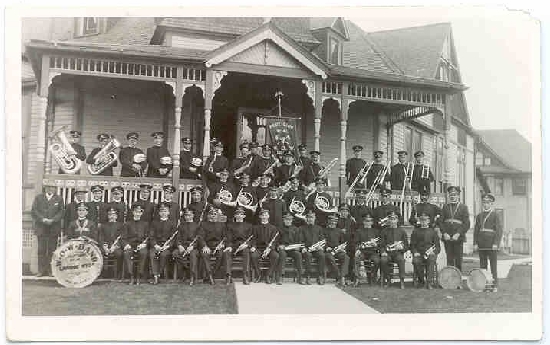
Woodmen of the World Band in front of Eagles Aerie
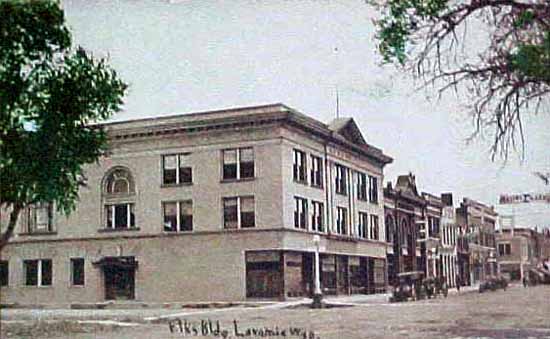
Laramie Elks Lodge, 1915
The Lodge building was constructed in 1910 at a
cost of $65,000. The social quarters are on the first floor. A large lodge room is
on the second floor. Originally there were rooms to let to bachelor or visiting Elks on the third floor.
In addition to the Elks, Eagles, and Woodsmen of the World, other lodges in Laramie included
the Masonic Lodge, organized in 1870, the Odd Fellows, the Knights of Pythias,
the Improved Order of Redmen (Wasatch Lodge No. 2) [For discussion of Redmen, see Casper],
and the Grand Army of the Republic (Custer Post #1). Indeed, James H. Hayford (1828-1902),
editor of the Laramie Sentinel and
himself a member of the Masons, complained of the number of lodges, most of whom met weekly:
A man of ordinary means can easily join enough to bankrupt himself in paying
fees, dues and initiation, and take all his time -- night and day -- to attend lodges.
It must be noted that in the early years of the 20th Century, there was a grain of
truth in Editor Hayford's observation. In Wyoming, just about every small town, no matter how small, had at least one
fraternal order, in most instances an Odd Fellows Lodge. Tie Siding, to the south of Laramie which probably never
exceeded 75 in population, had two orders, Star of the West Lodge #176, I.O.O.F., and Crook Post #80, G.A.R.
It has been estimated that at that time
25% of all American males belonged to a fraternal order. It has been estimated that at the
turn of the century there were approximately 2,000 American fraternal orders as widely diverse as
the Masonic Orders to the Order of Houn' Dawgs (Founded in 1912. Lodges were called
"Kennels.") and the Improved Order of Yellow Dogs.
The various orders had elaborate rituals which in many instances have now been
"simplified" as a result of the loss of members. None were, perhaps, more elaborate than
those of the Mystic Order of Veiled Prophets of the Enchanted Realm, which reputedly requires 40 prophets to
stage. The Laramie Elks Lodge still prides itself on its rendition of ritual. Elks Lodges
actively compete in the performance of ritual on a state and national basis. Laramie Elks
Lodge has twice, representing Wyoming, won the national competition over lodges from the remaining 49 states. Casper
Lodge has also won nationally.
And the notwithstanding the plethora of Lodges at the turn of the century, the amazing thing was that the men of
the day attended the Lodge meetings. The sad commentary on today's society is that not only are
all of the fraternal orders losing membership, but as one looks about a half empty lodge room, the
remaining members are not as loyal in their attendance.
Next page, The University of Wyoming.
|